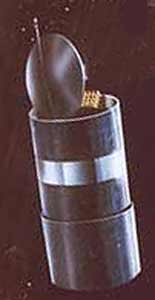Thank you very much for visiting Gunter's Space Page. I hope that this site is useful and informative for you.
If you appreciate the information provided on this site, please consider supporting my work by making a simple and secure donation via PayPal. Please help to run the website and keep everything free of charge. Thank you very much.
Anik D 1, 2 / Satcom 4R / Arabsat 1DR

Anik D1 [Boeing BSS]
Telecommunications in Canada expanded in 1982 with the 26 August launch of the Anik D-1 communications satellite. The new satellite offers Canadians live coverage of parliamentary debates, cable television, and continuity of television services, both nationally and regionally. Anik D-2, launched on the space shuttle 8 November 1984, was originally placed in a storage orbit and was made operational in November 1986. The satellite carries voice and data traffic.
Hughes Aircraft Company's Space and Communications Group, later Hughes Space and Communications Company, and today known as Boeing Satellite System, Inc., is the largest subcontractor on Anik D. Spar Aerospace Limited of Toronto, a longtime partner with Hughes in Canadian satellite communications, is the first Canadian prime contractor for a spacecraft. Anik D is built for Telesat Canada, a commercial company empowered by federal statute to establish and operate domestic satellite communications systems.
Anik D is based on the HS-376 communications satellite. The satellite serves all of Canada and operates in the 6/4 GHz C band. Hughes also built the Anik C satellite series, which operates in the 14/12 GHz Ku band and serves the more densely populated southern portions of the country. The two Anik D satellites replaced the three Hughes built Anik A satellites, which pioneered domestic satellite communications.
Anik D carries 24 transponders, each capable of transmitting 960 one-way voice circuits or one color television program. The HS-376 uses two telescoping cylindrical solar panels and a folding antenna for compactness during launch. Once the satellite is in synchronous orbit, 22,300 miles above the equator, the antenna is erected and the outer panel extended. This more than doubles the spacecraft's height and power output.
Anik D uses a spinning motion of 50 rpm to remain stable in orbit. Both the communications antenna and the electronics shelf are despun with respect to Earth and achieve a pointing accuracy better than 0.05 degrees. The transmit and receive beams are created by a shared aperture grid antenna with two polarization selective surfaces. The front surface is sensitive to horizontally polarized beams, the rear surface to vertically polarized beams. Each polarization reflects signals to separate feedhorns.
The satellite is 2.16 m in diameter, and 2.82 m high in the stowed position. With its 1.81 m wide antenna erected and the aft solar panel deployed, the satellite extends 6.57 m high. Anik D weighs 634 kg at beginning of life in orbit. Four thrusters using hydrazine propellant provide stationkeeping during the satellite's 10 year design life. The panels of K-7 solar cells provide 1000 Watts of electrical power at beginning of life, and three nickel-cadmium batteries furnish full power during eclipse operations, when the satellite passes through Earth's shadow.
Anik D operates in the C-band, with receive from 5.925 to 6.425 GHz and transmit from 3.7 to 4.2 GHz. The effective isotropic radiated power (EIRP) over the 36 MHz bandwidth is a minimum 36 dBw throughout Canada. Throughout portions of the United States, the EIRP is from 33 to 35 dBW. The satellite uses 11.5 Watt traveling wave tube amplifiers.
Anik D-1 was launched on a McDonnell Douglas Delta 3920 booster from NASA's Eastern Test Range. The Anik D satellites used a McDonnell Douglas payload assist module (PAM-D) for propulsion into elliptical transfer orbit, and they were boosted into near-synchronous orbit by Thiokol Corporation Star-30B solid propellant apogee motors. The satellites drifted into final orbit and were placed in operating position through the use of onboard thrusters. Anik D-1 is in orbit at 104.5 degrees West longitude, Anik D-2 is operating at 110.5 degrees West longitude.
| Nation: | Canada |
|---|---|
| Type / Application: | Communication |
| Operator: | Telesat Canada |
| Contractors: | Hughes |
| Equipment: | 24 C-band transponders |
| Configuration: | HS-376 |
| Propulsion: | Star-30B |
| Power: | Solar cells (body mounted and drop-skirt), batteries |
| Lifetime: | 10 years |
| Mass: | 1140 kg (634 kg BOL) |
| Orbit: | GEO |
| Satellite | COSPAR | Date | LS | Launch Vehicle | Remarks | |
|---|---|---|---|---|---|---|
| Anik D1 | 1982-082A | 26.08.1982 | CC LC-17B | Delta-3920 PAM-D | ||
| Anik D2 → Satcom 4R → Arabsat 1DR | 1984-113B | 08.11.1984 | CCK LC-39A | Shuttle [PAM-D] | with Discovery F2 (STS 51-A), Leasat 1, MMU 2-F3, MMU 3-F3 |
References:
- Boeing: Anik D
Further Anik missions:
|
Further Satcom missions:
|
Further Arabsat missions:
|
